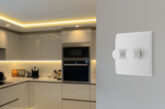
Miguel Aguado, Marketing & Technology Manager, and Steve Detmer, Residential Product Manager, both at Lutron Electronics, answer questions about the lighting trends that are set to shine in 2021.
Q. What has the commercial lighting industry learnt from last year?
MA: The challenges of 2020 have taught us that the way we use our buildings can change rapidly. Offices, hotels and leisure facilities have been most affected by the constant shifting of regulations and with this uncertainty set to continue into this year, it’s no longer possible, or wise, to prescribe a rigid lighting solution. This year we can expect major investment in solutions that empower and support the ever-changing use of our buildings, and a pull away from limiting, prescriptive systems that have been detrimental to building managers so far.
SD: Within the commercial space, the past year has proven to many employers that a remote working model can be just as effective as an office-based one. So, to warrant continued investment in an office space, facilities managers will need to ensure that their offices offer benefits that employees can’t get from home. Enhancing collaboration, productivity and well-being will be the main objectives of workspace design in 2021.
Q. How can lighting technology help facilitate the return to the office in 2021?
MA: The growing demand for this flexibility and adaptability can be met by the adoption of wireless technology. When returning to the office, many employers will be looking to employ temporary partitions or reconfigure space usage to meet social distancing guidelines. Wireless sensors and controls can be easily moved to facilitate these adaptations as they happen, taking minimal time to install and avoiding inconvenient and disruptive rewiring.
These solutions also help to achieve a more ‘contactless’ occupant experience. Using sensors instead of light switches avoids cross-contamination, giving employees peace of mind. Wireless systems can also further enhance user comfort and reduce risk through the application of personal controls, allowing occupants to modify their desk space or change the lighting in a room to optimise their environment for their current task.
SD: Managers of communal spaces will continue to be under pressure to be COVID-safe, and to future-proof for other possible disruptions as we’ve seen this year. Swapping hot-transmission spots, such as traditional light switches for ‘contactless’ solutions, will be a priority for office managers as employees return to the workplace.
Colour-tuning is an exciting lighting trend that is yet to see wide adoption in the office setting. This is a great solution to enhance well-being and productivity by giving occupants the ability to tune light – both natural and artificial – to suit their individual needs. Going forward, we can expect to see application of personalised colour-tuning in a bid to enhance occupant well-being, and offer an enhanced experience that employees can’t get from the home-office.
Q. What trends and challenges do you expect to see in the residential sector this year?
SD: 2020 re-defined our expectations of our homes and of technology, and these new parameters will set the tone for this coming year. In the residential sector, investment in lighting has already seen a boom that we expect to continue into 2021. The demand for smart home technology will continue to rise, especially as the office and the home converge. The benefits of smart lighting, such as energy savings, improved aesthetic and enhanced comfort will be the main consumer demands of lighting suppliers.
With demand also comes innovation. Therefore, in 2021, we can expect LED performance to take great strides as the industry learns more and prices come down, creating more accessible and widely adopted smart-home options. For residential customers, user experience will be a key driver of demand for lighting design and solutions for the coming year.
MA: Whilst these considerations and investments in occupant wellbeing are commonplace in commercial spaces, the home office doesn’t benefit from the same attention. Many may feel more comfortable working at home, but with no guidelines on lighting levels, air quality or posture support in the home, how can employee output and experience be optimised?
With widespread, long-term adoption of hybrid working expected to continue this year a renewed focus on optimising the home office will be needed by both employees and employers alike, in order to support productivity and employee wellbeing.
Get more details about the Lutron product offering by clicking here








